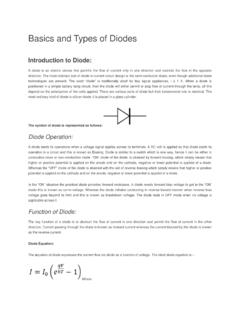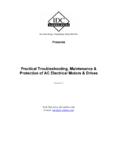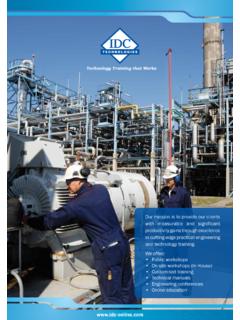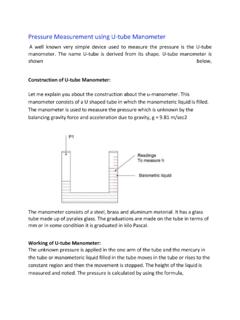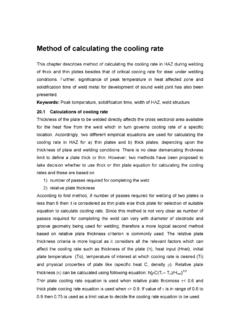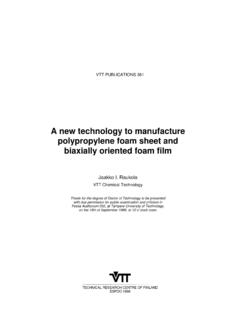Transcription of Quantum Mechanics Gibbs free energy - IDC-Online
1 Quantum Mechanics_Gibbs free energy In Thermodynamics, the Gibbs free energy (IUPAC recommended name: Gibbs energy orGibbs function; also known as free enthalpy[1] to distinguish it from Helmholtz free energy ) is a thermodynamic potential that measures the "usefulness" or process-initiatingWork obtainable from a thermodynamic systemat a constant temperature and pressure (isothermal, Isobaric). Just as in Mechanics , where potential energy is defined as capacity to do work, similarly different potentials have different meanings. The Gibbs free energy (SI units J/mol) is the maximum amount of non-expansion work that can be extracted from aclosed system; this maximum can be attained only in a completely reversible process.
2 When a system changes from a well-defined initial state to a well-defined final state, the Gibbs free energy G equals the work exchanged by the system with its surroundings, minus the work of the Pressure forces, during a reversible transformation of the system from the same initial state to the same final state.[2] Gibbs energy (also referred to as G) is also the chemical potential that is minimized when a system reaches equilibrium at constant pressure and temperature. Its derivative with respect to the reaction coordinate of the system vanishes at the equilibrium point. As such, it is a convenient criterion of spontaneity for processes with constant pressure and temperature. The Gibbs free energy , originally called available energy , was developed in the 1870s by the American mathematician Josiah Willard Gibbs .
3 In 1873, Gibbs described this "available energy " as the greatest amount of mechanical work which can be obtained from a given quantity of a certain substance in a given initial state, without increasing its totalVolume or allowing heat to pass to or from external bodies, except such as at the close of the processes are left in their initial condition.[3] The initial state of the body, according to Gibbs , is supposed to be such that "the body can be made to pass from it to states of dissipated energy by reversible processes." In his 1876magnum opus On the Equilibrium of Heterogeneous Substances, a graphical analysis of multi-phase chemical systems, he engaged his thoughts on chemical free energy in full.
4 Overview The reaction C(s)diamond C(s)graphite has a negative change in Gibbs free energy and is therefore thermodynamically favorable at 25 C and 1 atm. However, even though favorable, it is so slow that it is not observed. Whether a reaction is thermodynamically favorable does not determine its rate. In a simple manner, with respect to STP reacting systems, a general rule of thumbis that every system seeks to achieve a minimum of free energy . Hence, out of this general natural tendency, a quantitative measure as to how near or far a potential reaction is from this minimum is when the calculated energetics of the process indicate that the change G in Gibbs free energy is negative.
5 In essence, this means that such a reaction will be favoured and will release energy . The energy released equals the maximum amount of work that can be performed as a result of the chemical reaction. In contrast, if conditions indicated a positive G, then energy in the form of work would have to be added to the reacting system for the reaction to occur. The equation can also be seen from the perspective of both the system and its surroundings (the universe). For the purposes of calculation, we assume the reaction is the only reaction going on in the universe. Thus the entropy released or absorbed by the system is actually the entropy that the environment must absorb or release respectively.
6 Thus the reaction will only be allowed if the total entropy change of the universe is equal to zero (a thermal equilibrium state) or positive. The input of heat into an "endergonic" chemical reaction ( the elimination of cyclohexanol to cyclohexene) can be seen as coupling an inherently unfavourable reaction (elimination) to a favourable one (burning of coal or the energy source of a heat source) such that the total entropy change of the universe is more than or equal to zero, making the Gibbs free energy of the coupled reaction negative. In traditional use, the term " free " was attached to Gibbs free energy for systems at constant pressure and temperature to mean "available in the form of useful work.
7 "[2] For Gibbs free energy , we add the qualification that it is the energy free for non-volume work.[4] (A similar meaning applies used in conjunction with Helmholtz free energy , for systems at constant volume and temperature). However, an increasing number of books and journal articles do not include the attachment " free ", referring to G as simply " Gibbs energy ". This is the result of a 1988 IUPAC meeting to set unified terminologies for the international scientific community, in which the adjective free was supposedly banished.[5] [6] [7] This standard, however, has not yet been universally adopted. History See also: Thermodynamic free energy The quantity called " free energy " is a more advanced and accurate replacement for the outdated term affinity, which was used by chemists in previous years to describe the force that caused chemical reactions.
8 In 1873, Willard Gibbs published A Method of Geometrical Representation of the Thermodynamic Properties of Substances by Means of Surfaces, in which he introduced the preliminary outline of the principles of his new equation able to predict or estimate the tendencies of various natural processes to ensue when bodies or systems are brought into contact. By studying the interactions of homogeneous substances in contact, , bodies, being in composition part solid, part liquid, and part vapor, and by using a three-dimensionalVolume Entropy Internal energy graph, Gibbs was able to determine three states of equilibrium, , "necessarily stable", "neutral", and "unstable", and whether or not changes would ensue.
9 Hence, in 1882, the German scientist Hermann von Helmholtz stated that affinity is the largest quantity of work which can be gained when the reaction is carried out in a reversible manner, , electrical work in a reversible cell. The maximum work is thus regarded as the diminution of the free , or available, energy of the system ( Gibbs free energy G at T = constant, P = constant or Helmholtz free energy F at T = constant, V = constant), whilst the heat given out is usually a measure of the diminution of the total energy of the system (Internal energy ). Thus, G or F is the amount of energy " free " for work under the given conditions. Until this point, the general view had been such that: "all chemical reactions drive the system to a state of equilibrium in which the affinities of the reactions vanish".
10 Over the next 60 years, the term affinity came to be replaced with the term free energy . According to chemistry historian Henry Leicester, the influential 1923 textbook Thermodynamics and the free energy of Chemical Substances by Gilbert N. Lewis and Merle Randall led to the replacement of the term "affinity" by the term " free energy " in much of the English-speaking world. Graphical interpretation Gibbs free energy was originally defined graphically. In 1873, American engineerWillard Gibbs published his first thermodynamics paper, "Graphical Methods in the Thermodynamics of Fluids", in which Gibbs used the two coordinates of the entropy and volume to represent the state of the body.
